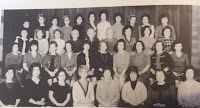blog. It may seem inconsequential to you, possibly even a bit silly, but I hope the significance and sincerity of this issue will become clear by the end. Ok, so here goes. A lot of people, especially in the Jewish community, are uncomfortable writing out the word "God." Instead, they write "G-d." I don't like this. In fact, I strongly oppose it. And last week, my disapproval graduated from annoyance to full-blown rant. Let me explain.
When confronted, people will often justify this practice by referring to one of the Ten Commandments: "You shall not take the name of the LORD your God in vain, for the LORD will not hold him guiltless who takes God's name in vain" (Exodus, 20:7). Though this mitzvah initially referred to invoking God's Name in oaths and curses, it eventually led
to the practice of not writing God's Name on anything. If a document or a book contains God's Name, it must be buried in a Jewish cemetery, it cannot simply be thrown in the trash. And I agree with this notion. HOWEVER, there are two significant problems with "G-d." 1) It's the wrong language. Our holy writ is Hebrew, NOT English. The cemetery-burial-rule only applies to God's Name in Hebrew. And 2) "God" is NOT God's Name. In Judaism, God is known as "Adonai" or "Elohim" (and again, I can write those names here, and you could print out my blog, and not need to bury that printout, because it's in English, not in Hebrew...). Every religion has its own names for God or their various gods, but the word "God" is a descriptor, not a name!!
So why was I so bothered by this right now? How did my anger come to boil over? For Purim, Ohev Shalom sent out Mishloach Manot to members of the congregation, and included a laminated card with blessings for various foods.
To my horror, not only did the card contain five instances of "G-d," but it also included God's ACTUAL Name - Adonai, IN Hebrew, known as the Tetragrammaton - written out completely! The authors were very careful about "G-d," but missed entirely the REAL problem of God's genuine Name spelled out fully; and now all the cards require burial. And THIS is why I'm truly upset. We focus so much on the fake thing, we actually miss the real issue that matters. And we obsess over something trivial, while inadvertently transgressing a true mitzvah. Needless to say, I was infuriated.
In the Haftarah this week, for parashat Tzav, God is speaking to Jeremiah, and in fact, it sounds an awful lot like a rant, maybe even a little similar to my own. On a much more serious topic perhaps, but God states: "... this is what I commanded them: Do My bidding, that I may be your God and you may be My people; walk only in the way that I enjoin upon you, that it may go well with you. Yet they did not listen or give ear; they followed their own counsels, the willfulness of their evil hearts" (Jeremiah 7:23-24). Ours is a lesser version of this problem, but I can see how people start out fixating on something irrelevant, and it eventually leads them on a path of real transgression,
of actually violating something much more severe, much more problematic. I know that "G-d" is not a big deal in the grand scheme of things, but I truly believe it speaks to a blind-leading-the-blind mentality, where we stop thinking about what really matters and accept customs and behaviors simply because "everyone else is doing it." To close out my rant, I want to offer a final, seemingly-silly quote, but which I actually think is true and critical. In the famous "Harry Potter" book series, the powerful villain, Voldemort, is never referred to by name, except by Harry and his mentor, Dumbledore. Early in the series, Dumbledore addresses the stupidity of not using Voldemort's name, stating: "Call him Voldemort, Harry. Always use the proper name for things. Fear of a name increases fear of the thing itself." I couldn't have said it better myself, even though unlike Voldemort, God need not be feared. Stop using "G-d." It's a distraction, it's counterproductive, it's pointless.
Rant over. Thank you.
Photos in this blog post:
1. Image courtesy of chabad.org
2. CC image courtesy of Aaaaaaaable on Wikimedia Commons
3. Image of blessing card courtesy of my iPhone. The blessing card itself came from Party Judaica LLC.
4. CC image courtesy of Karen Roe on Wikimedia Commons















